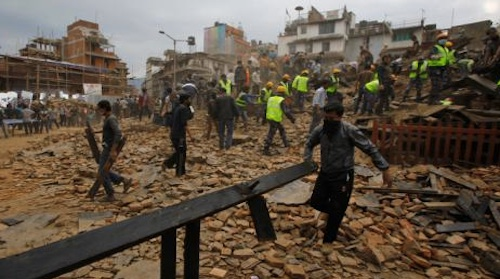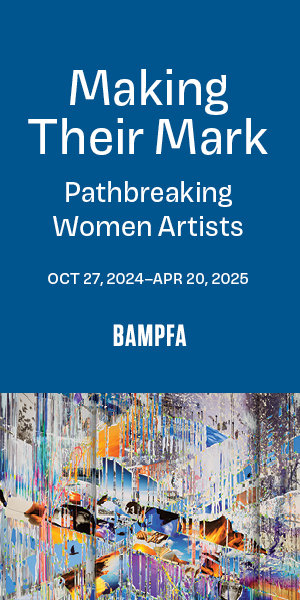Lots of press attention on devastated monuments — but do we care as much about lives?
By Sandip Roy
APRIL 30, 2105 — Soon after the news of the 7.9 earthquake reverberated through social media, I, like many others I knew, shared on Facebook a dramatic picture of the destruction wrought by it.
It was a BEFORE and AFTER picture of Kathmandu’s historic Darbar Square, the magnificent UNESCO designated World Heritage site now reduced to rubble, years of painstaking human endeavor and pride just casually brushed aside by the tectonic forces of nature.
A couple of days later the death toll has hit 4,400 and rising as news trickles in from remote villages flattened by the earthquake. But in some ways to the rest of the world, those before and after images of palaces and temples and tower overshadow the enormity of that human loss and its devastation.
On one hand it is a reminder of how powerful culture and history and heritage is to the idea of a country. If today something happened to the Taj Mahal or the river front in Varanasi, grief and mourning would sweep across India and the world and a gaping hole left in its history. On the other hand, at a time when the death toll is still mounting, and thousands are stranded on the street, the inconsolable grief over “irreplaceable” wood and brick also feels disquieting – smacking of the picture-postcard mourning of the far-away tourist.
The tourism angle is an enormous part of the Nepal story unfolding around the world. In Bhuj an earthquake was just an earthquake, a natural disaster, not perceived really as a loss of heritage. The images from Nepal resonate around the world because so much of the world has been to Nepal, has posed in front of those monuments that have now crumbled to dust. Nepal exists in albums and home videos around the world in a way a Bhuj does not. And while the face of a child at a relief camp, or a long queue at a food rationing centre, makes us shake our heads and sigh, we have seen those pictures over and over again from many parts of the world. They are interchangeable and while tragic, sadly do not have the drama of the BEFORE and AFTER pictures of the toppled Dharahara tower. There is no doubt about which one we will click on, which one is more “shareable”.
This is not unique to Nepal. When the Taliban destroyed the Bamiyan Buddhas the shockwaves were heard around the world. That act became the symbol of the irrational barbarism of the Taliban, more than the atrocities they were inflicting on their own people – the public execution by stoning in stadiums or the blinding of girls who attended school or the plight of the 7.4 million refugees in Pakistan and Iran alone before the Americans even went to war against Kabul. The “senseless” destruction of the Buddhas helped make the Taliban even more of an international pariah, different from run-of-the-mill dictatorships. Iran’s state television in an odd turn of phrase condemned the Taliban’s “inhuman and violent behavior” for its demolition of monuments. “All we are breaking are stones,” shrugged Mullah Omar in response. In an echo of Mahmud of Ghazni at the Somnath Temple, he asked Afghans if they would rather be “smashers of idols or sellers of idols”.
A western cultural expert told The Guardian in despair “I consider myself a friend of Afghanistan. I have spent fifteen years trying to help the country. But it is becoming an island of madness.” It’s one thing to not care about democracy and human rights but to be so cavalierly dismissive of tourism and culture felt truly baffling. The Taliban angrily complained that the world seemed more concerned about offering money to save the statues instead of offering aid to save the starving people of Afghanistan, in effect turning the statues from artefacts into idols, venerated more than human lives. Kofi Annan, then the UN Secretary General said it was “not going to be easier now to raise money for the humanitarian crisis” in Afghanistan. But the cultural gap was stark. While most of the world mourned the statues, Jamal Elias, a professor of religious studies at the University of Pennsylvania noted that the Lahore-based daily Nawa-I Waqt ran a full page article comparing how the suffering of children failed to move the West, while earthen statues brought out their “sympathy”.
This is not to say the Bamiyan Buddhas or the palaces and temples of Bhaktapur and Darbar Square were not priceless or that their destruction, whether by man or nature, is not literally a monumental tragedy. This is part of a heritage and it cannot be rebuilt or pieced back together like a jigsaw. “The loss of inheritance has made bearing the loss of human lives even more difficult,” laments Luxmee Maharjan, a journalist who worked with the Kathmandu-basedHimalayan Times.
If anything it is affirming to know that culture, which is often on the cutting block in government budgets, is not just the preserve and responsibilities of the UNESCOs of the world, that its loss can shake us to the core. But the grief over the destruction and looting of the National Museum in Iraq has to be viewed in context of the ravages of the larger American-led war in that country. When an ISIL group takes a sledgehammer to ancient statues in Mosul, the Iraqi prime ministerpledged to protect Iraq’s heritage as if the ISIL, with their grisly execution videos, had not crossed the norms of civilization long before they defaced a 40-tonne Assyrian winged bull.
The problem lies not in mourning the loss of priceless heritage. That loss should indeed be mourned. In an ideal world the rebuilding of lives and the rebuilding of monuments should not come at the expense of each other. The destruction of Patan could in fact help keep the world’s attention focused on the larger destruction in Nepal and help in rebuilding the country as a whole. Or one could eclipse the other.
In Afghanistan, a post-Taliban government keenly aware of the symbolic power of the Bamiyan Buddhas declared that rebuilding them would be a “cultural imperative”. There was even a proposal by a Japanese artist to mount a $64 million windmill-energy powered sound and laser show to project Buddha images at Bamiyan. Elias writes “many people have questioned the ethics of spending large sums to make replica statues in a country where the overwhelming majority of the population lives without personal security or the basic necessities of life.”
Nepal, a poor country far more dependent on tourism than Afghanistan, will face these same thorny moral dilemmas in the days ahead. And the world will need to remember that Nepal is not just a home for old temples and palaces and Everest expeditions. The 3700 (and counting )dead in Nepal are also a part of its lost inheritance. For them Nepal was home and not just a tourist backdrop.
Sandip Roy is author of “Don’t Let Him Know” and editor of First Post, where this article originally appeared.




